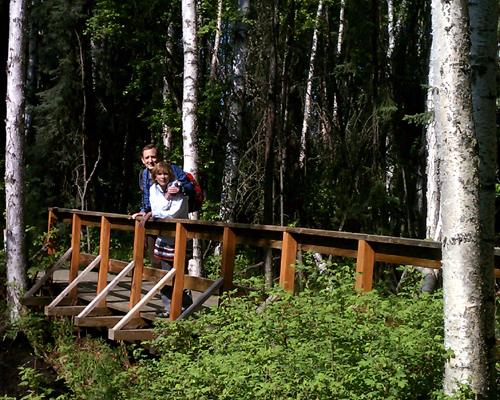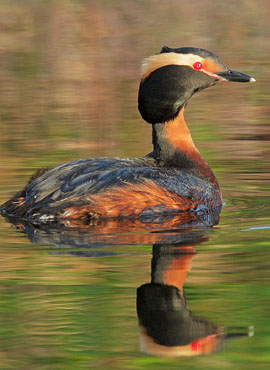
The reserve is a not-for-profit privately managed 2000 acres of wetlands, boreal forests and grass fields. This conjunction of varied ecosystems is unusual this far north and the much of the wetland portion actually dries up not too long from now.
Located just at Fairbanks’ northern perimeter and very close to the university, it’s a heavily used park and not just by birders. Joggers, moms and tots and dog walkers probably out number the birders, but it’s the birders who rule!
I went with Mark Ross, the resident biologist, on the annual “birdathon.” That’s a two-hour race through the area during which Mark tries to identify as many species as possible. The record for this time of year is 36.
That will sound depressingly small to those of us living further south, where I had just completed the breeding bird survey (in the northwestern tip of Illinois) and came up with 86 species. Actual bird censuses over the best of the migration could double both counts.
That still pales in comparison to what I normally see on a two-week East African safari where we normally easily identify over 300 species traveling through areas with a census of well over 700.

As you move south, the biomass grows denser. But what is so special about the Fairbanks reserve is exactly the opposite: here we’re hitting the limit of many inland bird species, and watching how their numbers alter over the years provides one of the fastest and truest glimpses of the health of the planet.
In Africa, Illinois and here in Fairbanks, this year is looking good. Fairbanks residents, for example, identified several birds in healthy numbers that are considered “concerned” species, including the yellow-bellied flycatcher and violet-green swallow.
We saw the swallow in fairly large numbers. This despite some horrible accounts of how the swallows were dying hardly a month ago because there was still so much snow in Fairbanks, which was unusual.
Fairbanks easily gets to 50 to 60 below, but is normally not deep with snow. It’s a dry, near desert environment. This year, however, there was lots of snow, and that wasn’t good for the early arriving migrants like the violet-backed swallow.
You’ve probably read about the heavy snow in other parts of Alaska as well. Last year, for example, the coastal community of Cordova at one point at 15′ of snow on the ground. Contrary to what most people in the lower 48 think, Alaska is not a place that historically records large snowfalls. That’s changing, because the world is heating up.
And how the birds respond to this is fascinating.

That’s kind of remarkable. We tend to think of bird migrations as an all-out effort from start to finish, with no real capacity to slow down or speed up. If Mark’s right, that notion is wrong and it could mean that birds are going to adapt to global warming better than the residents of Manhattan.
We had a great time in Fairbanks with some of the group taking the famous Riverboat Discovery cruise, and others visiting friends including Alaska’s longest serving judge who gave them a tour of her chambers here, and Christi and Ken visiting a distant nephew who is young but gold digging!
The town is filled with history, mired somewhat in its remoteness, and the last vestige of modern man before the great tundra and arctic beyond. We won’t go that way. We’re heading south.
To Denali! Stay tuned.